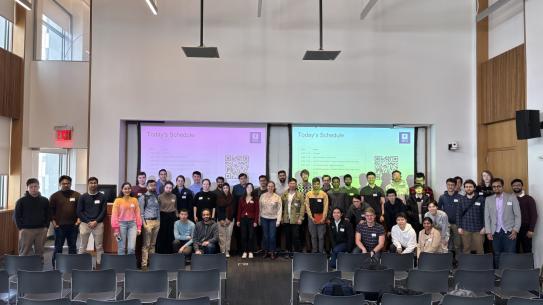NYU Tandon School of Engineering Awarded Highly Competitive $260,000 NEH Grant to Digitize New York City Record
Grant to Fund Digitizing the City Record 1873 to 1998: Making Transparent New York City Government Infrastructure and Political Economy
(Brooklyn, NY) The NYU Tandon School of Engineering today announced it has been awarded a highly competitive $260,000 grant from the National Endowment for the Humanities to digitize the City Record. The project, which will be led by Jonathan Soffer, Professor of History and Chair, Department of Technology, Culture & Society at Tandon, will digitize the 1,723 volumes – or one million pages – of the City Record, from 1873-1998 and make them openly and freely available to the public on nyc.gov.
These volumes contain copious data on every aspect of the city’s politics, society, economy, real estate and infrastructure development, employment, and expenditures and will aid scholars studying the city because of the depth and breadth of the data it contains, offering digitized resources unmatched by any other city. The digitized City Record Project will alter both the quantitative and qualitative study of post-Civil War New York as much as the wide availability of searchable digitized newspapers has in recent years.
The database will provide a treasure trove for public users (students, bankers, home buyers, family historians, urban planners, journalists) investigating the historical and financial development of New York property and infrastructure, or researching family history, with data going back generations to the 1870s. Moreover, its significance is not limited to New York City. As Stanford University historian Richard White observes, “It is the kind of project that has the potential to remake how we think about critical historical processes.” and “the most robust digitization project that [he has] ever read.”
Jonathan Soffer, Professor of History and Chair, Department of Technology, Culture & Society at Tandon, who will lead the project, said, “We believe that the digitization of The City Record will have an important impact on urban history and economics, and across the social science disciplines. No other city of New York’s size and importance provides a comparable historical database. Due to the location of the portal on the heavily used nyc.gov website and the diversity of the data, we believe that this project will have an unusually large audience.”
NYU Tandon School of Engineering Dean Katepalli Sreenivasan said, "The use of innovation to preserve historical data is an exciting opportunity for us and generations to come. I want to praise the National Endowment for the Humanities for their vision and congratulate Professor Soffer on undertaking this important task."
“The City Record is one of New York City’s oldest continuously published newspapers – available every weekday, except for legal holidays, without fail since June 24, 1873. Digitizing these documents will further our understanding of how this City has evolved over time. This project will provide a powerful tool for increasing government transparency, creating a fully searchable database of more than a century of records,” said Commissioner Lisette Camilo, Department of Citywide Administrative Services (DCAS)
“We are pleased to acknowledge the National Endowment for the Humanities continuing support for preservation of the nation’s historical documents and applaud NYU Professor Jonathan Soffer‘s commitment to making information about New York City government available. Successful completion of the project to digitize the City Record and make it available online via the City’s government publications portal will provide limitless opportunities for research into a little-known, but rich resource for the study of New York City,” said Pauline Toole, Commissioner, New York City Department of Records & Information Services.
“The enormous corpus of data produced by this project, thanks to the National Endowment for the Humanities, represents a major contribution to the community of researchers studying the history of New York City’s built environment. The City Record data will open unprecedented opportunities to investigate, both at the micro and macro levels, the social, political and economic forces driving the historical transformation of the city,” said Matthew A. Knutzen, The New York Public Library, Linda May Uris Director, Humanities and Social Sciences Research Divisions.
Urban reformers started the City Record in 1873 to promote transparency after the famous Tweed Ring scandals. It publishes weekly reports and regulations from every department of city government, listing every payment, contract, appointment to office, infrastructure project, and vital statistics, such as weekly reports on contagious diseases.
The City Record includes an abundance of data on both the built and natural environment. Some examples include the periodic reports of all city agencies:
- meeting minutes of the City Council and the Board of Estimate
- contracts, payments, and bids for water, sewers, and streets
- weekly reports on mortality and health and meteorological data
- the disposition of law suits against the city,
- documents on the construction of major historic buildings, such as the New York Public Library at 42d Street and the American Museum of Natural History,
- thousands of documents that touch on the fabric of everyday life in New York City, such as the 1873 regulations for driving cattle through the streets of Manhattan, even the very first traffic code for automobiles (1901)
- official canvasses of election, down to the election district level from 1878-1940, which can be compared with manuscript censuses,
- lists of who worked for the city in minor jobs, and what they did, and who and why they were promoted, disciplined, or fired, and how much money they earned
- complaints from citizens
- reports on the Municipal Lodging House, including the weekly enumerations of the ethnicities of the homeless and the length of time they had been in the city
- lists of property left by prisoners and the dead, yet unclaimed
The NYU Tandon School of Engineering dates to 1854, when the NYU School of Civil Engineering and Architecture as well as the Brooklyn Collegiate and Polytechnic Institute (widely known as Brooklyn Poly) were founded. Their successor institutions merged in January 2014 to create a comprehensive school of education and research in engineering and applied sciences, rooted in a tradition of invention, innovation and entrepreneurship. In addition to programs at its main campus in downtown Brooklyn, it is closely connected to engineering programs in NYU Abu Dhabi and NYU Shanghai, and it operates business incubators in downtown Manhattan and Brooklyn.


